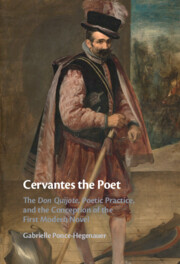 Cervantes the Poet
Cervantes the Poet Published online by Cambridge University Press: 11 May 2023
The Introduction begins with the situating of the DQ at a turning point in Foucault’s History of Madness in order to draw out the fate of the Renaissance poet as that which Cervantes’ modern novel most obviously and most covertly dramatizes. Positing the unknown history of the Don Quijote as the oft-elided career of nearly four decades that Cervantes spent as a sixteenth-century author of pastoral verse and prosimetric poetry, the Introduction reconfigures the history of the modern novel through the reconstruction of sixteenth-century poetics, the poetics of Pastoral Petrarchism. While Velázquez’s Las Meninas has often been studied as a paradigmatic work of the transition from Renaissance to Baroque (oft-coupled with the DQ), the Introduction returns to Velázquez’s painting of El bufón llamado don Juan de Austria in order to more closely examine Cervantes’ role in this transition as an aging contemporary of the original Don Juan de Austria, a favorite patron of poet-soldiers. Engaging both the figure of the poet and the figure of the modern madman in the transformations of the DQ as exemplar of the modern novel and the modern subject, the Introduction lays the historical foundations and theoretical stakes of Cervantes the Poet.
To save this book to your Kindle, first ensure [email protected] is added to your Approved Personal Document E-mail List under your Personal Document Settings on the Manage Your Content and Devices page of your Amazon account. Then enter the ‘name’ part of your Kindle email address below. Find out more about saving to your Kindle.
Note you can select to save to either the @free.kindle.com or @kindle.com variations. ‘@free.kindle.com’ emails are free but can only be saved to your device when it is connected to wi-fi. ‘@kindle.com’ emails can be delivered even when you are not connected to wi-fi, but note that service fees apply.
Find out more about the Kindle Personal Document Service.
To save content items to your account, please confirm that you agree to abide by our usage policies. If this is the first time you use this feature, you will be asked to authorise Cambridge Core to connect with your account. Find out more about saving content to Dropbox.
To save content items to your account, please confirm that you agree to abide by our usage policies. If this is the first time you use this feature, you will be asked to authorise Cambridge Core to connect with your account. Find out more about saving content to Google Drive.